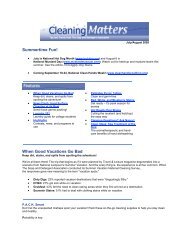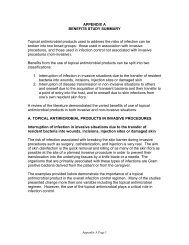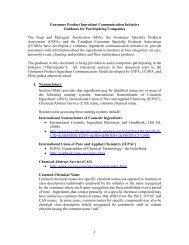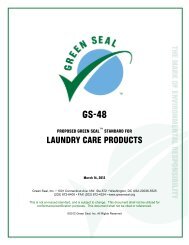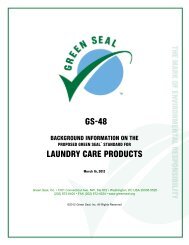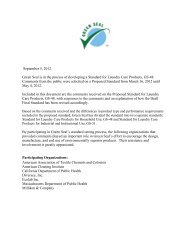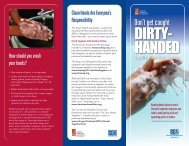subchapter c -- federal hazardous substances act regulations
subchapter c -- federal hazardous substances act regulations
subchapter c -- federal hazardous substances act regulations
You also want an ePaper? Increase the reach of your titles
YUMPU automatically turns print PDFs into web optimized ePapers that Google loves.
(3) Testing procedure. Except as provided<br />
in paragraph (b)(4) (i) and (ii) of this section,<br />
the toy shall be dropped four times from a<br />
height of 3 feet ±0.5 inch (0.92 meter) onto the<br />
imp<strong>act</strong> medium described in paragraph (b)(2)<br />
of this section. The toy shall be dropped in<br />
random orientation. After each drop, the test<br />
sample shall be allowed to come to rest and<br />
shall be examined and evaluated before<br />
continuing.<br />
(4) Large and bulky toys. (i) A toy that has<br />
a projected base area of 400 or more square<br />
inches (2,560 or more square centimeters)<br />
shall be tested for imp<strong>act</strong> in accordance with<br />
paragraph (b)(4)(iii) of this section. The base<br />
area for toys with permanently attached legs<br />
shall be measured by calculating the area<br />
enclosed by straight lines connecting the<br />
outermost edge of each leg of the perimeter.<br />
(ii) A toy that has a volume of more than 3<br />
cubic feet (0.085 cubic meter), calculated by<br />
the major dimensions without regard to minor<br />
appendages, shall be tested for imp<strong>act</strong> in<br />
accordance with paragraph (b)(4)(iii) of this<br />
section.<br />
(iii) The toys described in paragraph (b)(4)<br />
(i) and (ii) of this section shall be tested for<br />
imp<strong>act</strong> by tipping them over three times by<br />
pushing the samples slowly past their centers<br />
of balance onto the imp<strong>act</strong> medium described<br />
in paragraph (b)(2) of this section.<br />
(c) Bite test — (1) Application. A toy (or<br />
component or any accessible portion thereof)<br />
that has an external dimension of 1.25 inches<br />
±0.05 inch (3.18 centimeters) or less and a<br />
design configuration that would permit a child<br />
to insert a portion into the mouth in any<br />
orientation up to a biting thickness of 1.25<br />
inches ±0.05 inches (3.18 centimeters), for a<br />
penetration of at least 0.25 inch (0.635<br />
centimeter), shall be subject to this test.<br />
(2) Test equipment — (i) Cont<strong>act</strong><br />
mechanism. The cont<strong>act</strong> mechanism shall be<br />
two metal strips or plates each measuring 0.25<br />
inch ±0.002 inch (0.635 centimeter) high and<br />
each having a cont<strong>act</strong> edge radius of 0.020<br />
inch ±0.002 inch (0.05 centimeter) for at least<br />
a 150-degree cross-sectional arc. A suggested<br />
cont<strong>act</strong> mechanism appears in figure 1 of §<br />
1500.51.<br />
(ii) Loading device. The loading device<br />
shall be a scale or force gauge having an<br />
accuracy of ±0.5 pound (±225 grams).<br />
16 CFR Ch. II (1–1–05 Edition)—proposed modificication – 6/25/06<br />
-- 61 --<br />
(3) Testing procedure. The test article shall<br />
be placed in the cont<strong>act</strong> mechanism in any<br />
reasonable position for a penetration of 0.25 to<br />
0.5 inch (0.64 to 1.27 centimeters), which<br />
position utilizes less than 180 degrees of the<br />
arc of the cont<strong>act</strong> mechanism, and a test load<br />
increasing to 50 pounds ±0.5 pound (22.74<br />
kilograms) shall be evenly applied within 5<br />
seconds. This load shall be maintained for an<br />
additional 10 seconds.<br />
(d) Flexure test — (1) Application. This<br />
test shall be applied to each component of a<br />
toy containing metal wire(s), or other metal<br />
material(s), for stiffening or for retention of<br />
form if the component can be bent through a<br />
60-degree arc by a maximum force of 15<br />
pounds ±0.5 pound (6.80 kilograms) applied<br />
perpendicularly to the major axis of the<br />
component at a point 2 inches ±0.05 inch (5<br />
centimeters) from the intersection of the<br />
component with the main body of the toy or at<br />
the end of the component if the component is<br />
less than 2 inches ±0.05 inch (5 centimeters)<br />
long.<br />
(2) Testing procedure. The toy shall be<br />
secured in a vise equipped with vise shields<br />
that are fabricated from 13- gauge cold-rolled<br />
steel or other similar material and that have a<br />
0.375-inch (0.95-centimeter) inside radius.<br />
The component shall then be bent through a<br />
60-degree arc by a force applied at a point on<br />
the component 2 inches ±0.05 inch (5<br />
centimeters) from the intersection of the<br />
component with the main body of the toy or<br />
applied at the end of the component if the<br />
component is less than 2 inches (5<br />
centimeters) long. The component shall then<br />
be bent in the reverse direction through a 120-<br />
degree arc. This process shall be repeated for<br />
30 cycles at a rate of one cycle per two<br />
seconds with a 60-second rest period occurring<br />
after each 10 cycles. Two 120- degree arc<br />
bends shall constitute one cycle.<br />
(e) Torque test — (1) Application — (i)<br />
General. A toy with a projection, part, or<br />
assembly that a child can grasp with at least<br />
the thumb and forefinger or the teeth shall be<br />
subject to this test.<br />
(ii) Toys with rotating components.<br />
Projections, parts, or assemblies that are<br />
rigidly mounted on an accessible rod or shaft<br />
designed to rotate along with the projections,<br />
parts, or assemblies shall be tested with the rod<br />
or shaft clamped to prevent rotation.



